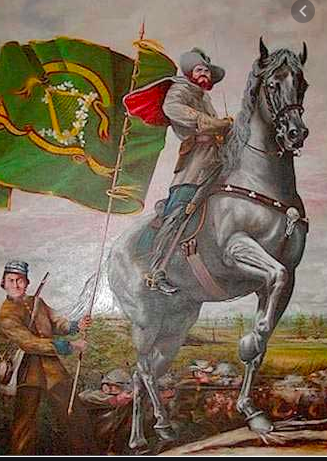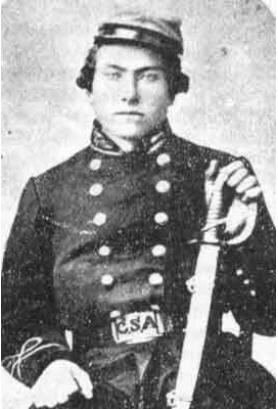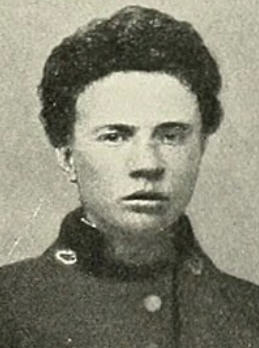Not Lost, Not Gone

(Artist Jerry McWilliams painted the scene above from the battle of Raymond, MS, in 1863. The figure on horseback is Colonel Randall McGavock, who was mortally wounded by Union fire and fell into Pat’s arms. He is depicted at the lower left. The great Rebecca Blackwell Drake, a former State Department player was instrumental in saving the ground near her home on which the fighting occurred.)
So, the latest version of the American Civil War is being fought again right here in Culpeper County. We do a fair amount of tourist trade over the views of our lush green pastures and the memories of the two armies that tread on them in the heart of hat conflict. Occupied by Lee and Grant, in turn for winter quarters, the claim is that this county saw more conflict than any other in the sprawling war.
When I bought Refuge Farm, this history was new to me, and with my cousins, we did some digging on the family tree. We discovered that our great great grandfather James served a three year enlistment in the Union Army, but his grave is not marked with the usual decorations associated with the veterans groups of the time. We were curious, and I reviewed his service record at the Archives in Washington to find out why. The family wanted to ensure he was honored for his service, and it was a bit of a shock to discover that the Army had declared he was a deserter. There were mitigating circumstances, of course, and we all agreed that it was better that he failed to return to his unit after a leave period in which he fell for Barbara, our great great Grandmother, and were wed. She convinced her new husband to stay with her, rather than return to the 72nd Ohio Volunteer Infantry.
Well, as you can imagine, the trials of an immigrant Irish family that did not arrive in America until 1848 was quite a sensation in our little group, and all the amazing stories that emerged about who we were, and where we came from. James left one account of hat it was like to be in the Army of that time, but otherwise left no account of his life after departing the service. There were some references to work in a dry goods concern back in Ohio, but otherwise only mention from Mom about what the family was like in the 1920s.
It was quite remarkable to fill in the old family reference to Pat, Barbara’s brother, who had a gift for blarney and left quite an account of his life in the tumult of war. Most of his obituary surfaced this week during a frantic scan of disassociated documents related to the classic hot rod I finally decided to sell, and it was galvanizing in the context of all the current commotion about our history, which of course is under revision.
I sent you the first part of Pat’s obituary last week. It explained why he joined the Confederate Army in Tennessee- “The bloody Tinth, Irish!” It is a wild and roaring tale, filled with explosions and courage, and the observation that he gained some renown at the end of it for his skill in blowing up Federal supply trains. At that point there was little difference between Pat and the insurgents we are fighting now, four or five generations later.

I did not impose the second part of the obit on you. That part went on to describe the rest of Pat’s honorable life in Nashville when the fighting was done. Despite my interest in colorful members of the family, it is fairly staid going, trumpeting his accomplishments in managing the repair shops of the Chattanooga and Nashville Railway. Also referenced was his friendship with a guy named S. A. Cunningham, a local Nashville publisher. Pat’s commitment to his fellow veterans was also mentioned as a mark of his civic pride. It was respectful, and ended with a couplet that did not survive the years in the copy I had.
I didn’t know what paper had published it back in 1921, and that commenced a flurry of research after the big flatbed truck finally belched smoke and hauled my favorite truck away. It was one of those strange emotional moments, seeing it go, and I was ready to put that aside and channel the energy into something else.
It took a while. I searched for “obituary couplets- 1921” and all the other assorted terms I thought might help me complete the missing line of Pat’s death notice. There are a lot of poems out there in the world, and century old obituaries are a deep pit in which to plunge. I went back to the text I had, and looked at the railroad that was mentioned- pretty neat. The terrain round Nashville had some daunting aspects, and completing the steel road was a feat of some engineering marvel at the time. No poetry, though.
I felt I had hit a dead end, and I only needed to find one line to have a complete copy of the obituary. Looking through the text, I saw a reference to a pal of his, S.A. Cunningham, who apparently had some fame at the time. I decided to see what I could find on him, hoping perhaps his death notice might shed some light on Pat’s passing. What I found astonished me. Having been focused on Pat’s wartime service, it appeared that there was something equally memorable in what happened to Southern society in the aftermath of the titanic struggle.
I mean, we are still fighting about ancient flags and imposing dark metal statues of people no longer remembered. It turns out that Sumner A. Cunningham drew a lot of water in his day, and Pat was proud to be his pal. I will have to get to that tomorrow, and Sumner’s role in creating the Lost Cause narrative we learned as history in school, and on the silver screen in epics like “Gone With the Wind.”
In the meantime, I will leave you with the second half of Pat’s obituary, couplet complete:
“A short while after the close of the war, Captain Griffin entered the service of the N., C. & St. L. Railway and gradually worked his way to foreman of the company’s shops. The company’s property under his jurisdiction was more diligently cared for than if it had been his own. His practical wisdom, ready sympathy, and generous spirit of moderation, combined with his unqualified loyalty and his gift for leadership, earned for him friends in every walk of life, and among the best beloved of these were those old comrades, whom he he knew as “friends through the gold and the gray to the valley of the shadow and beyond,” among them being the late S.A. Cunningham, in whose effort to to place before the world the true history of the South in the great conflict he was greatly interested. His home was the gathering place for these friends, and his children were taught to accord them all honor.
In railroad and fraternal circles Captain Griffin was shown much preferment, but the most treasured of all honors was conferred upon him by Company B, Confederate Veterans, of Nashville, Tenn., when they made him their captain.
To the members of his family he has left a heritage of lasting qualities that will unfold in value as they are increasingly realized and understood. To have lived with him in the intimate relations of life is a lingering joy and benediction. Though we know that, clothed in his old gray uniform he has tenderly laid away and that his soul has passed to the bivouac of the life abundant, so much of his courageous and helpful personality lingers in his old environment that we are confident
“He has not wandered far away…”
He is not lost, or gone.”
I was gratified at seeing the documents complete, and more to the idea that the last line reflected the fact that Uncle Pat is still with us. But there is something more here, about Mr. Cunningham, and the war that we are fighting again. Tell you more about that tomorrow.

(Sumner A. Cunningham, 41st Tennessee Infantry, CSA)
Copyright 2020 Vic Socotra
http://www.vicsocotra.com
